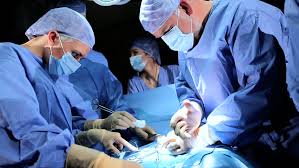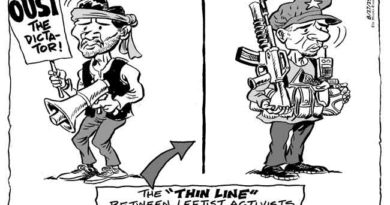COLUMN: FIRST THINGS FIRST– Did DU30 get a new kidney? – By Francisco S. Tatad
FIRST THINGS FIRST

TWO complementary sources, neither of which wants to be named, have claimed that on Wednesday morning, Jan. 29, 2019, President Rodrigo Duterte underwent a successful kidney transplant surgery amid rumors that he had fallen seriously ill.
The first source said a team led by Dr. Rose Marie Rosete-Liquete, the nation’s first woman kidney transplant doctor and executive director of the National Kidney and Transplant Institute (NKTI), performed the procedure at the Cardinal Santos Medical Center in San Juan, Metro Manila. The second source said the same doctor performed the same procedure on the same patient on the same day, but in Davao.
Cardinal Santos or Davao?
According to the first source, DU30 checked in at Cardinal Santos on Tuesday evening, after attending the premier presentation of former PNP chief and senatorial candidate Bato de la Rosa’s biopic at SM Mega Mall, Ortigas Center. The next day he underwent his surgical procedure. He reportedly spent the next couple of days recuperating in a medically furnished luxury suite at Ortigas Center before he flew to Davao.
The second source tried to add a personal testimonial by saying that he himself had a kidney transplant late last year, and that he and the President now shared the same transplant doctor. His operation was virtually painless, he said, and he was back on his feet less than a day after the operation. He said the latest protocol on kidney transplants allows the doctor to attach a third kidney, which takes the place of the old pair, without touching them, unless they cause problems such as high blood pressure or infection.
This was what the doctor did to him, he said, and this was likely what the doctor did to the President as well. But he insisted it happened at a medical facility in Davao, not in San Juan. Upon hearing this, I went back to my first source to ask them if there wasn’t any chance they could have confused Cardinal Santos for Davao. They stood firm on their original claim, pointing out the great inconvenience of doing it in Davao. Indeed, if DU30 was in Manila on Tuesday and was going to undergo a major surgery the next day, it made no sense to fly to Davao the evening before, when he could have rested in Manila on Tuesday evening to prepare for the surgery the next morning.
A difficult story
It is not easy for me to report this story. The President is particularly sensitive about his state of health, and he tends to take personal offense at any discussion of it in the press. I write regularly as a critic, but I want to keep whatever goodwill exists between me and the President. Still, we each have our respective duties. At the beginning of his presidency, DU30 disappeared from public view during the New Year holidays. His spokesman then, Ernesto Abella, could not say where he was—no one had seen him in Davao or in Manila, and yet Abella insisted he never left Davao. When the media pressed him on this point, Abella finally said, “Maybe he left Davao, after all.”
As a former presidential spokesman for at least 10 years, I found this unacceptable. So I asked: “Where then did he go? Did he, by any chance, go to the Fuda cancer hospital in Guangzhou, as someone had suggested online?” I was more interested in getting a competent and responsible statement from the Palace spokesman than in tracking down the President’s actual whereabouts. But my query drew not only a negative reaction from the Palace, and also a confirmatory report from one foreign diplomatic observer who reported seeing a photo (a “selfie”) of a Filipino health worker with the President in Fuda.
The Fuda case
I was not interested in staying with the story, so I told the National Security Adviser Gen. Hermogenes Esperon during a Manila Hotel social function that I had dropped it altogether, but that he should tell the President about the alleged photograph from Fuda which could surface anytime in the mainstream or social media without my intervention. I was doing this against my interest as a newspaperman, but I thought the President could use a little help at the time.
The gesture was, however, completely misunderstood, for a few days later, in a speech before the troops in Mindanao, DU30 mocked me for allegedly spreading the news about his visit to the cancer hospital. He then confirmed having gone to Fuda, but only to find out, he said, where “Tatad had himself circumcised” so that he could have his own faulty circumcision fixed too.
It was coarse humor, but it’s DU30’s kind of humor and I did not take it against him. I continued to write about the President, but tried to avoid writing about his health, unless completely unavoidable, for obvious reasons. But the matter cannot be avoided now, in the face of this claim by two complementary sources that he had undergone a major surgical operation. The President and his spokesman may want to dismiss it mechanically as “fake news,” but it is bound to occupy some political space for some time.
The better course would be for the President’s official physician rather than his spokesman to issue a medical bulletin on his state of health and general well-being. This will not stop all the speculations, but it would show the President’s respect for the right of the public to be informed about his physical and mental well-being.
Marcos’ kidneys
This is not the first time I got caught up in a story of this type. In 1983 and 1984, after I left the Cabinet, where I had been press secretary, presidential spokesman and secretary of public information from 1969 to 1980, and returned to journalism, I helped expose then-President Marcos’ two secret kidney transplants. Dr. G. Baird Helfirch, director of renal transplants for Georgetown University Medical Center in Washington, D.C.and Dr. Edgar Milford at Harvard’s Brigham and Women’s Hospital in Boston, performed Marcos’ first transplant in August 1983. Dr. Barry Kahan, director of transplantation at Houston’s Hermann Hospital, performed a second transplant in 1984, after Marcos suffered a rejection of his 1983 donated organ.
The Palace tried to hide these procedures from the public, but with the help of civic-minded individuals, these were ultimately uncovered. Dr. Enrique Ona, one of the country’s leading kidney specialists, who eventually became president of the Philippine National Kidney Foundation (PNKF) and later Secretary of Health, confirmed these transplants years after Marcos fell from power in 1986 and died in 1989. On Nov. 2, 1984, Dr. Potenciano Baccay, PNKF vice president and one of Marcos’s personal physicians, was found stabbed to death, “supposedly by the communists,” after reportedly talking to the foreign press about the transplants.
Effects on the Constitution
Toward the end of his days, Marcos was rumored to be suffering from lupus. But his authoritarian control of government put the state of his health beyond the reach of the press and the public. This created such an enormous political grievance that when Cory Aquino’s appointive constitutional commission wrote the 1987 Constitution, they included, among other things, Section 11 of Article VII, which provides as follows:
“Whenever the President transmits to the President of the Senate and the Speaker of the House of Representatives his written declaration that he is unable to discharge the powers and duties of his office, and until he transmits to them a written declaration to the contrary, such powers and duties shall be discharged by the Vice President as Acting President.
“Whenever a majority of all the Members of the Cabinet transmit to the President of the Senate and to the Speaker of the House of Representatives their written declaration that the President is unable to discharge the powers and duties of his office, the Vice President shall immediately assume the powers and duties of the office as Acting President.”
Section 12 of the same Article provides: “In case of serious illness of the President, the public shall be informed of the state of his health. The members of the Cabinet in charge of national security and foreign relations and the Chief of Staff of the Armed Forces of the Philippines shall not be denied access to the President during such illness.”
Urgent questions
Given the private claims about the President’s reported kidney transplant, a number of questions arise.
—Is the President suffering from an actual “serious illness”? Neither the Constitution nor any existing law defines this term, so who will define it? A kidney transplant is normally regarded as a major surgical procedure. According to Wikipedia, the following risks could occur: allergic reaction to general anesthesia; bleeding; blood clots; leakage from the ureter (the tube that connects the kidney to the bladder); blockage from the ureter; an infection; rejection of the donated kidney; failure of the donated kidney; heart attack; a stroke.
—Assuming the information coming from private informants is correct, does the situation activate the provision of Sec 12, Article VII, of the Constitution? But this provision is poorly written. It merely provides that the Cabinet members in charge of national security and foreign relations and the AFP Chief of Staff (which means Defense Secretary Delfin Lorenza, National Security Adviser Hermogenes Esperon, Foreign Secretary Teodoro Locsin Jr. and Gen. Benjamin Madrigal) shall not be denied access to the President during his illness, but nothing compels the President to summon these officials and reveal his precise health condition on his own. And nothing compels these officials to inquire into the President’s state of health should he decide to keep them guessing.
The President must oblige us with a full statement.


 All photographs, news, editorials, opinions, information, data, others have been taken from the Internet ..aseanews.net |
All photographs, news, editorials, opinions, information, data, others have been taken from the Internet ..aseanews.net | 






